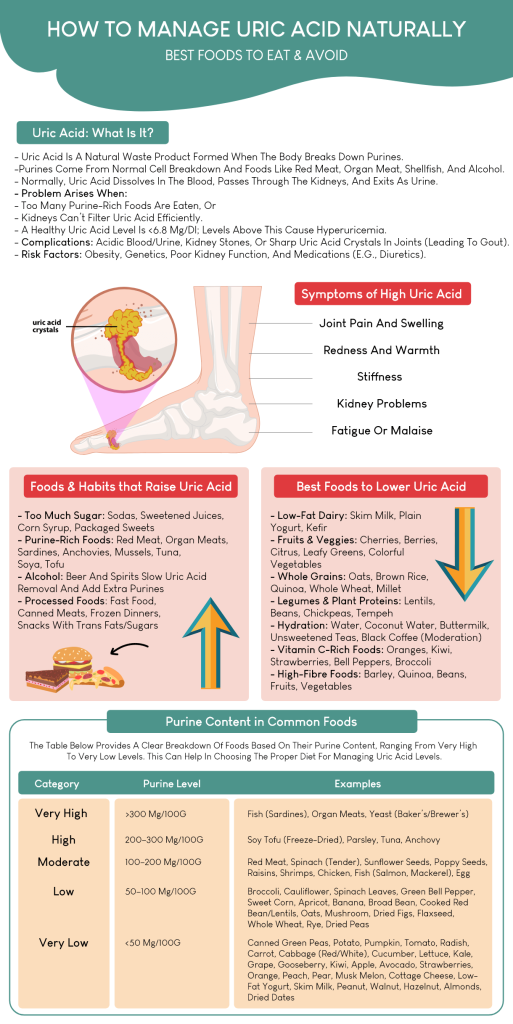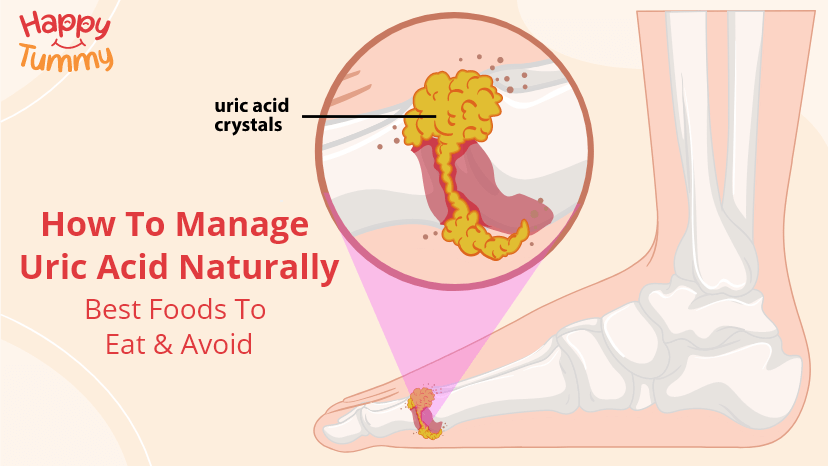Table of Contents
“Do you often wake up with pain in your joints?” Do your toes or knees hurt when you try to move them?
Or maybe your health records said you had high levels of uric acid, and you were left wondering what that meant?
If you said yes to any of them, you’re not the only one. High uric acid has quietly become a frequent problem.
It might show up as gout, pain, or just that nagging worry you get every time you look at your test results. The good news is that what you eat can make a big difference.
Some meals can help keep your uric acid levels in check on their own, while others may be making matters worse without you even knowing it.
In this article, we’ll talk about the best foods to eat and the sneaky ones to stay away from. This will help you take small, natural steps towards feeling better and happier.
Uric Acid: What Is It?
Our bodies naturally produce uric acid as a waste product during the digestion of purine-rich meals. [1]
Purines are substances that are naturally produced in our bodies as cells decompose and can be found in some foods, particularly red meat, organ meat, shellfish, and alcohol.
Uric acid travels via the kidneys, dissolves in the blood, and is excreted as urine.
However, uric acid begins to accumulate in the blood if you consume an excessive amount of purine-rich meals or if your kidneys are unable to filter it out quickly enough.
Typically, a healthy uric acid level is less than 6.8 mg/dL.[2] Hyperuricemia is the term for the condition when it exceeds that threshold.
Over time, this excess can cause your blood and urine to become overly acidic, which can occasionally lead to kidney stones, or it can form sharp crystals in your joints.
The uric acid levels in the body can be elevated due to obesity, genetics, chronic or decreased kidney function, and certain medications, such as diuretics.

Symptoms of High Uric Acid
At first, high uric acid levels may not be recognised, but when they reach a certain level, the body starts to send out warning signs. Some of the most prevalent signs are:[3]
- Joint pain and swelling: It happens mainly in the knees, ankles, or big toe. This discomfort might come on unexpectedly, usually at night, and it can feel acute or throbbing.
- Redness and warmth: The joints that are affected may look swollen and feel hot to the touch.
- Stiffness: It can hurt to move your joints, which makes ordinary tasks difficult.
- Kidney Problems: Sometimes, elevated uric acid can cause kidney stones, which can make your back hurt, make you feel sick, or make it hard to urinate.
- Fatigue or malaise: High uric acid levels can sometimes make you feel fatigued all the time.
Causes of Hyperuricemia
When there is too much uric acid in the blood, hyperuricemia develops. The key reasons are:[4]
- Overproduction of uric acid
- Consuming meals high in purines (such as red meat, seafood, and sugary drinks)
- Genetic or metabolic conditions
- Under-excretion of uric acid
- Kidney illness or impaired kidney function
- Not enough water in the body or less blood flow to the kidneys
- Medicines (Diuretics, niacin, and certain antibiotics)
- Hormonal or metabolic disorders (hypothyroidism, acidosis)
- Other factors – Obesity, alcohol, and a lot of fructose in the diet make it harder to get rid of waste and make more of it.
Not everyone with excessive uric acid will have all of these symptoms, but if you don’t take care of it, it can cause gout attacks to happen again and again and destroy your joints.
Foods to Avoid with High Uric Acid
Some meals can make the situation worse by adding more purines to your body when your uric acid levels are high.
To assist in keeping your uric acid levels in check, you should limit or stay away from the following foods:
1. Stay Away from Sugar
If you eat too much sugar, especially fructose, your uric acid levels may go up. When your body breaks it down, it could let out purines, which might make the blood have more uric acid.[5]
Drinks like sodas and sweetened juices contain fructose, which is absorbed considerably faster than the natural sugars found in whole fruits. That’s because drinks don’t have protein, fibre, or other nutrients that slow things down.
Other sugars, such as table sugar, corn syrup, and high-fructose corn syrup, may also raise uric acid levels.
Simple ways to eat less sugar:
- Pick more whole, unprocessed foods
- Cut back on packaged sweets and snacks
- Look for hidden additional sugars on labels
- Eat fresh fruit over fruit juices to satisfy your hunger
- Instead of sugary drinks, consume water, unsweetened tea, or black coffee
Aashirvaad Atta with Multigrains came up with the Digestion Quotient. You can now find out your “score” on digestion by taking a two-minute questionnaire that asks you questions about your digestive health.
2. Limit Purine-Rich Foods
Your body breaks down purines into uric acid. Eating a lot of foods high in purines may raise uric acid levels, which may lead to gout attacks or joint pain.[6]
You don’t have to stop eating them altogether, but it’s best to restrict how often you do.
Be careful with these foods that have a lot of purines:
- Red meats
- Liver, kidney, and heart are examples of organ meats
- Some seafood, like sardines, anchovies, mussels, and tuna
- Soya and Tofu
Don’t eat too many of these things; instead, aim to balance your meals with lean meats like chicken or turkey in small amounts. It can also help to eat more plant-based meals like beans, lentils, and tofu.
And if you do eat foods strong in purines, eating small amounts can help a lot with uric acid levels.
3. Beer and Other Alcoholic Drinks
Drinking alcohol, especially beer, may raise uric acid levels. Alcohol causes uric acid to accumulate in your blood because it slows down your body’s ability to eliminate it.
Beer is especially bad since it has extra purines in it that your body transforms into uric acid. This makes the load much heavier.
Drinking a lot can also make your kidneys more irritable and stressed, which makes it difficult for your body to stay in balance.[7]
4. Heavily Processed Foods
Highly processed foods may not generate uric acid directly, but they can make it harder for your body to get rid of it.
Foods that have a lot of added sugars, trans fats, and sodium may cause the kidneys to work harder and make inflammation worse.[8] [9]
The kidneys are in charge of getting rid of uric acid from the blood.
Eating an excess of processed meals, such as fast food, packaged snacks, frozen dinners, canned meat, and other processed foods, may make illnesses like gout and kidney difficulties worse. These things can make uric acid build up.
Eating whole, fresh foods instead of items that have been highly processed may help your body stay healthy, your kidneys operate better, and your uric acid levels stay in check on their own.
Best Low-Purine Foods to Eat
Eating the correct foods and dropping certain foods may help keep uric acid levels in control over time.
These are some of the best foods to eat that can help keep your uric acid levels in check and make you healthier in general.
1. Low-fat Dairy Products
Low-fat dairy products can help keep uric acid levels in balance.[10] They have amino acids that could assist your body in breaking down uric acid and getting rid of it more quickly.
You can get these benefits by adding low-fat or nonfat milk, plain yoghurt, and kefir to your diet. These foods are also good sources of protein and calcium.
- Pick: plain yoghurt, low-fat or non-fat milk, or kefir
- Stay away: Full-fat or sweetened dairy products because they can contribute more sugar or saturated fat.
Adding low-fat dairy to meals or snacks can be a simple and efficient way to keep your uric acid levels in check while still eating a healthy, balanced diet.
2. Fruits and Vegetables
Consuming a lot of fruits and vegetables might help with inflammation and uric acid levels.
Cherries, berries, and citrus fruits are good for you because they have vitamins, antioxidants, and anti-inflammatory characteristics that may help lessen your risk of gout flare-ups.[11]
- Pick: Fresh fruits and veggies
- Stay away: Sweet fruit cups and fruit juice.
Putting a lot of colourful fruits and vegetables on your plate not only helps you keep your uric acid levels in check, but it also makes it easier to eat healthier.
3. Whole Grains
Whole grains may help keep uric acid levels stable since they are low in purines and high in fibre.[12] Fibre may help with digestion and help the body control uric acid levels better.
Fibre may slow down the absorption of sugar, which manages blood sugar surges that could lead to more uric acid generation.
- Pick: Oatmeal, whole grain bread, brown rice, millets, quinoa, bulgur, or oat bran.
- Stay away: White bread, white rice, or sugary breakfast cereals.
Eating whole grains daily may help with both uric acid management and general metabolic health, especially for persons who have diabetes or insulin resistance.[13]
Aashirvaad Whole Wheat Atta is made using the best grains, which gives it a lovely amber colour and density. Aashirvaad makes atta that is 100% Sampoorna Atta and contains no maida.
4. Legumes and Plant-Based Proteins
Lentils, beans, tofu, and chickpeas are all plant-based proteins that may help manage inflammation and improve kidney and general health.
These foods have moderate amounts of purines, but they don’t raise the risk of gout like red or organ meats do. They also have a lot of fibre, antioxidants, and other good plant chemicals.[14]
- Pick: lentils, black beans, chickpeas, dried peas, or tempeh
- Stay Away: Red meat, poultry skin, or processed plant-based meats that are heavy in sodium and additives.
Adding beans and other plant proteins to your meals will help you get the protein you need in a healthy and long-lasting way while also helping to manage lower uric acid levels naturally.
5. Water and Unsweetened Drinks
One of the easiest ways to help your body deal with uric acid is to drink enough water. Drinking a lot of water helps your kidneys get rid of extra uric acid, which lowers the chance of crystals forming in your joints.
Drinks without sugar, decaffeinated herbal teas, and black coffee in moderation can also help you stay hydrated without adding sugar.
- Pick: Water, fruit-infused water, tender coconut water, buttermilk.
- Stay away: Sugary drinks, including soda, sweetened teas, energy drinks, and fruit juices that have a lot of fructose.
It’s easy to stay hydrated and keep your uric acid levels in check if you carry a water bottle with you and drink from it throughout the day.
You can also switch out sugary drinks for unsweetened ones.
6. Foods High in Vitamin C
Adding foods that are high in vitamin C to your diet might help your body deal with uric acid better.[15]
Vitamin C is essential for your health overall, and it may assist your kidneys in getting rid of extra uric acid, which lowers the chances of flare-ups and crystal formation.
- Choose: oranges, grapefruits, strawberries, kiwi, bell peppers, broccoli, and leafy greens.
- Stay Away From: Sugary fruit drinks or meals that are too processed and state they are “vitamin C-fortified” but include extra sugar.
Adding a lot of fruits and vegetables that are high in vitamin C to your meals will help lower uric acid levels and boost your overall health and immunity simply and naturally.
7. High-Fibre Foods
Eating foods that are high in fibre may help your body keep uric acid levels in check.
Fibre can slow down how quickly sugar gets into the blood, which may stop spikes that generate more uric acid. It can also help the body get rid of waste by helping the kidneys and digestive system get rid of too much uric acid.[16]
- Pick: Oats, barley, brown rice, quinoa, lentils, beans, fruits, and veggies
- Stay away from: Processed foods with little fibre and refined grains
Aashirvaad Atta with Multigrains worked with well-known dietitians to create the My Meal Plan test. The test finds out how much fibre you consume every day and then makes a meal plan that works for you.
Purine Content in Common Foods
The table below provides a clear breakdown of foods based on their purine content, ranging from very high to very low levels.
This can help in choosing the proper diet for managing uric acid levels.
| Category | Purine Level | Examples |
| Very High | >300 mg/100g | Fish (sardines), organ meats, yeast (baker’s/brewer’s) |
| High | 200–300 mg/100g | Soy tofu (freeze-dried), parsley, tuna, anchovy |
| Moderate | 100–200 mg/100g | Red meat, spinach (tender), sunflower seeds, poppy seeds, raisins, shrimps, chicken, fish (salmon, mackerel), egg |
| Low | 50–100 mg/100g | Broccoli, cauliflower, spinach leaves, green bell pepper, sweet corn, apricot, banana, broad bean, cooked red bean/lentils, oats, mushroom, dried figs, flaxseed, whole wheat, rye, dried peas |
| Very Low | <50 mg/100g | Canned green peas, potato, pumpkin, tomato, radish, carrot, cabbage (red/white), cucumber, lettuce, kale, grape, gooseberry, kiwi, apple, avocado, strawberries, orange, peach, pear, musk melon, cottage cheese, low-fat yogurt, skim milk, peanut, walnut, hazelnut, almonds, dried dates |
The Bottom Line
You can keep your uric acid levels in check naturally by eating the appropriate foods, drinking enough water, and living a healthy life.
Eating fruits, vegetables, whole grains, legumes, and plant-based proteins, as well as low-fat dairy, may help your body get rid of uric acid and control inflammation. It might also keep your kidneys safe.
If you drink a lot of water and other liquids that don’t have sugar in them, you can control your extra uric acid.
Eating foods rich in vitamin C can also assist with this. Foods that are strong in fibre may also help keep uric acid levels in line by helping with digestion and preventing spikes that could boost uric acid levels.
It’s also vital to cut back on meals high in purines, alcohol, sugary drinks, and highly processed foods that can make uric acid levels rise.
Eating a balanced diet and avoiding excessive consumption are essential for maintaining good health.
If you’re worried about uric acid or other health issues, you should always go to a doctor or other healthcare professional for personalised advice.
Frequently Asked Questions
When your body breaks down purines from food and cells, it makes uric acid, which is a natural waste product. When levels are high, they may cause gout, kidney stones, and joint pain; therefore, it’s crucial to control them with food and lifestyle.
Limit meals heavy in purines, like red meat, organ meats, and some seafood, as well as alcohol (particularly beer), sugary drinks, and highly processed foods that may raise uric acid levels or put stress on the kidneys.
Foods that are high in vitamin C, high in fibre, and low in fat will help keep uric acid levels in check and improve the health of your kidneys and joints.
Your kidneys can get rid of extra uric acid by drinking an adequate amount of water during the day. To stay hydrated, always have eight glasses of water throughout the day.
Yes! Maintaining a healthy weight range, exercising regularly, drinking sufficient water, eating a balanced diet, and reducing consumption of alcohol and processed foods may all help regulate uric acid levels.
Hyperuricemia happens when there is too much uric acid in the blood because the body makes too much of it (from eating foods high in purines, breaking down cells too quickly, or having a genetic predisposition) or doesn’t get rid of it properly (from renal problems, some drugs, or dehydration). Obesity, alcohol, and sugary drinks are some of the lifestyle variables that might make the illness worse.
















